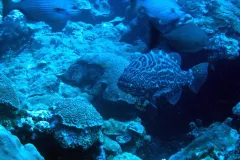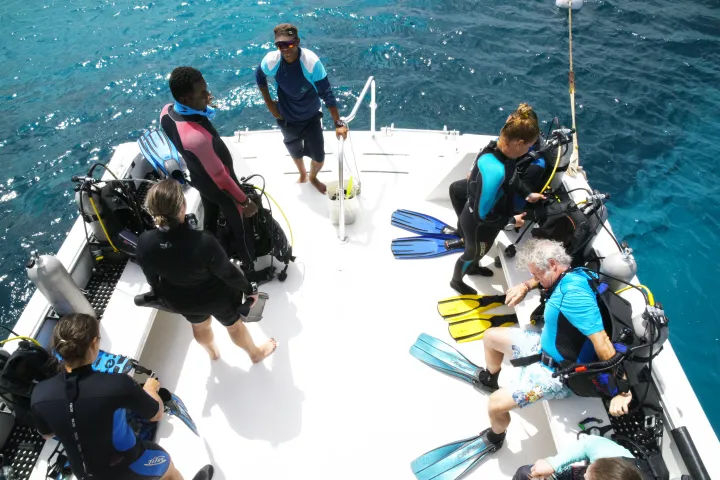Protecting the Most Vulnerable Fish After an Oil Spill

When an oil spill happens, there are thousands of species affected, everything from invertebrates to fishes to birds to mammals (in addition to human impacts). Scientists and governments must rush to assess the most efficient ways to reduce the impact on the surrounding ecosystem—a triage of sorts just like any emergency room.
Marine biologist and environmental chemist Beth Polidoro, an Associate Professor at Arizona State University, studies the impacts of pollution on marine species, ecosystems, and human health. With the help of other researchers in the field, Polidoro has been working to develop and apply a new approach to understand the effects of toxic chemicals on marine species in the Gulf of Mexico, one that will hopefully help in the decision-making process when an oil spill happens.
In June 2019, experts in the field met in Cuba to develop a framework for identifying what traits to measure that were related to oil exposure. The goal was to devise a scale that ranks species based on their relative vulnerability or resilience to petrochemical toxins based on life history traits (which include habitat type, diet, life-span, sexual and migratory behaviors).
These different traits were then scored based on if a species would be more resilient or more vulnerable when exposed to oil and gas. With this, researchers were able to create a framework, that could be used to assess any species response to oil in the environment. “It provides a way to prioritize, if there was an oil spill, which species might be more vulnerable based on what we know about their traits,” Polidoro said.
The fact that this framework is widely applicable is important to note. Traditional approaches to understanding the effect of toxic chemicals on marine species have drawbacks. “You’re really limited on the types of species you can raise in the lab and then you also tend to do it under controlled conditions where you’re throwing one chemical at it at a time to see what happens,” Polidoro said. “The reality is in real-life, you don’t get just one thing. You're getting all sorts of stressors at the same time.” Polidoro estimates that of the roughly 15,000 marine species in the Gulf of Mexico, only about 300 previously had toxicology data available.
Researchers are beginning to put this new framework to use. As a graduate student, Megan Woodyard’s thesis work was entirely focused on creating the vulnerability index for fishes. With support from Arizona State University and the Gulf of Mexico Research Initiative (GoMRI) Woodyard was able to produce an index for around 1,700 species of fishes, sharks, and rays.
After the Deepwater Horizon oil spill occurred in the Gulf of Mexico, it was unclear which animals were at the highest risk and which should be the focus of clean-up efforts. But through the creation of the fish vulnerability index, researchers are beginning to identify factors that are particularly important to consider when recovering from an oil spill.
In Woodyard’s research, she found that habitat is one of those factors. Animals that spend more time at the surface of the water are more vulnerable. There, the sun’s UV rays can interact with petrochemical toxins, which further increases their toxicity.
The information that comes from creating a vulnerability index can help to guide management efforts, ensuring researchers are prepared to consider more at-risk areas and species first. “We're trying to create a tool that can help decision-makers that aren't as familiar with the species themselves and all the ecological aspects of petrochemical spills,” Woodyard said.
Woodyard hopes that the index can be utilized as a conservation management tool to help after an oil spill. While it would be ideal to stop drilling all together, Woodyard understands this isn’t likely to happen. “People aren’t going to stop drilling in the Gulf, there’s a ton of oil there,” Woodyard said. “We can’t just say ‘Stop drilling, that will help all species.’ We need to develop methodologies to create a response for when it happens.”
In the decade since the Deepwater Horizon oil spill, researchers have come a long way in understanding management, conservation, and clean-up efforts. As oil drilling continues in underwater environments around the world, vulnerability indices like this could prove to be useful tools in case of emergency.
________________
The Ocean Portal receives support from the Gulf of Mexico Research Initiative (GoMRI) to develop and share stories about GoMRI and oil spill science. The Gulf of Mexico Research Initiative (GoMRI) is a 10-year independent research program established to study the effect, and the potential associated impact, of hydrocarbon releases on the environment and public health, as well as to develop improved spill mitigation, oil detection, characterization, and remediation technologies.
For more information, visit http://gulfresearchinitiative.org


